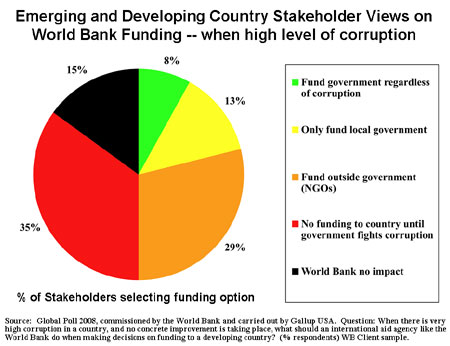The Good
Aid effectiveness has become a central notion in the lexicon of the aid industry. This is in contrast to two decades ago, when official donors would not hesitate to provide major funding to governments like that of Mobutu in Zaire and Marcos in the Philippines. Such extreme misgovernance in official aid by traditional donors is rare today. For instance, even though multilateral financial institutions continue to fund governments where there is high level corruption and tend to be silent about dramatic governance debacles such as in Zimbabwe, at least they refrained from funding Mugabe’s government during the worst excesses.
Further, for over a decade there has been increasing recognition that aid flowing to governments implementing ineffective policies is wasteful, in line with research findings since the early 1990s. As a result, aid has tended to support domestic policy reform efforts of recipient countries, even though narrow political objectives of donors still play a dominant role in many aid decisions today.
The official donor aid community has also become committed to improving aid effectiveness through better coordination mechanisms, as illustrated by the important Aid Effectiveness High Level Forum (HLF) process initiated in Rome in 2003, followed by the (unusually) substantive and concrete Paris Declaration in the second HLF held in early 2005. At that time official donors agreed on certain targets to be met by 2011. A serious monitoring mechanism was put in place.
Even though the Aid Effectiveness High Level Forum (HLF) agenda focused narrowly on donor harmonization and coordination, some governance topics featured explicitly in the Paris HLF agenda, notably on public sector management (the “supply side,” e.g. public finance management and country procurement systems). The problem of corruption was mentioned, and commitments were made on transparency and “mutual accountability.”
The third installment of the HLF was recently held in Accra, Ghana, this past September. As compared with the previous Paris HLF, the event in Accra was much more inclusive, significantly broadening the participation of Civil Society Organizations (CSOs). During the Accra HLF itself, CSOs were critical of the lack of transparency on how official donor monies are spent, and demanded that such items be explicitly included in the final resolution (the “Accra Agenda for Action”). At the eleventh hour, this was done. While not path-breaking, these last minute changes signaled an “official” recognition of the role that CSOs can play.
The Bad: The Silent Crisis in Governance and Anticorruption
While actual implementation of the Paris Declaration has progressed in some fronts, in many areas progress is at glacial pace, such as on “mutual accountability.” There is also high variation across donors and recipients in their commitment to this aid effectiveness agenda. And recipient governments often see conditionality as being reshaped rather than reduced, and their own coordination on capacity development is wanting.
A general commitment on transparency is certainly important for aid effectiveness, yet it will not suffice on its own. Governance and anticorruption are as important, yet except for rhetoric and some initiatives on transparency, they were accorded little attention at the recent HLF in Accra. In fact, the Paris declaration of many years ago was more explicit and further ahead on these issues than the very recent Accra HLF communiqué, suggesting that backtracking has taken place in this area.
The recent neglect in addressing difficult challenges in good governance and anticorruption reflects the silent crisis plaguing the governance and anticorruption movement more broadly. Contrary to the importance these issues enjoyed worldwide earlier in the decade, in concrete terms they have now low priority in the aid effectiveness agenda. The Accra HLF merely mirrors such broader development.
Fifteen years ago, governance, anticorruption and transparency in aid were largely ignored. Since the mid-1990s multilateral and bilateral official donor agencies paid much more attention to these issues. A multitude of projects and programs to assist on governance were started throughout the world, supported by many aid agencies. Yet over the past few years, the priority accorded to governance in aid has slackened. And the strategies and programs that donors implement nowadays are concentrated on the technocratic “supply side,” while often ignoring the need for supporting those governance and anti-corruption measures that matter the most for development.
In its silent crisis, the anticorruption field and movement has not been able to effectively transition from the awareness-raising stage to the concrete action-oriented stage, nor from a supply side public sector management narrow focus to one encompassing the most relevant demand side challenges, and one that embraces a multitude of stakeholders. And the political dimensions of governance and corruption, which are key to improve aid effectiveness, have been often ignored or addressed naively.
Instead, the focus today is on technocratic supply side discussion on “capacity;” on how donors can help “fix” technocratic issues through “harmonization”, infusions of technical assistance and “capacity,” by decreeing “ownership” by the recipient (often segments of central governments), and by often advocating to set up yet another new and insular institutional setup in a recipient country (e.g. project implementation units tailored to donor requirements, anticorruption commissions with no teeth, etc.)..
At the time of the Accra HLF it should already have been abundantly clear that aid effectiveness was not to materially improve by mere efforts to “harmonization” and by further exhortations on “ownership”, or by discussing division of labor in providing “capacity building”. In reality, aid effectiveness will be determined by much more fundamental issues than those, such as governance. If governance is lacking, or, say, there is pervasive corruption in government or capture by the elite, a “well harmonized” donor funding strategy to government officials who fully “own” the program would have negative results.
For years already (and certainly by the 2008 Accra HLF), the evidence has been clear that not only economic policies matter for aid effectiveness, but at least as important as determinant of aid effectiveness are good governance and corruption control. Empirical analysis indicates that governance and corruption significantly affect the likelihood of a successful aid project. More fundamentally, good governance and anticorruption are essential to ensure that aid supports domestically-led governance reforms and that it results in country-wide development and poverty alleviation impact.
The Ugly: Facing Up to the New World Reality
The low priority given nowadays to the governance and corruption challenge is not the only indicator that part of the “aid effectiveness” field appears to be behind the curve. Absent from Accra’s HLF last year were the path-breaking IT innovations, in spite of the fact that they offer great promise to improve governance and aid effectiveness. Similarly, the traditional aid industry may not yet be grasping the seismic shift that has taken place as a result of private donor aid, trade, sovereign funds and new official donors such as China. Also absent from the official aid effectiveness Accra HLF were the innovative market- and private-driven solutions to development challenges.
Enter now the global financial crisis. The fact that the aid industry is in need of a revamp has now become even stronger. Furthermore, once we draw the implications of the crisis, the particular priorities within governance may need to be altered in moving forward.
This is because the world reality has fundamentally changed, and, within it, the role of government. Almost one-half of the financial industry in many rich countries has been wiped out, exposing major governance and corruption deficiencies in the US and other industrialized and emerging economies. The global economy, which is now mired in a deep recession, is under threat. Donor aid flows to developing countries are being compromised. Domestically, the US is attempting to quickly disburse trillions of dollars in financial bailout and stimulus packages, with many key OECD and important middle income countries following suit – including China. Many emerging economies and developing countries are preparing stimulus packages, and in some cases financial bailouts as well.
The major ongoing shift in the role of government is multi-dimensional: governments will fund major infrastructure and other investments, select which financial institutions to provide massive public funds, own major financial and other assets; patch up social (and housing) safety nets, and also revamp and expand its regulatory role over the financial sector.
Each one of these new dimensions of the role of government carries governance and corruption risks, which will need to be addressed, over and above the long-standing governance challenges in these areas which were pending from before. Donor agencies, bilateral and multilateral, and of course the IMF, are gearing up to try and quickly assist many governments in providing fast (and often large) infusions of funding. The governance and anti-corruption aspects of such endeavour require a much higher priority than accorded so far.
Selected Implications
Some circumspection and humility by traditional donors is in order, since the example starts at home. The governance failures in the US and other industrialized nations leading to the financial crisis was a rude reminder that these challenges are not the exclusive domain of developing countries. The probems of state and regulatory capture, of “legal corruption”, and of vested interests unduly influencing the rules of the game will need to be addressed in many countries, high- and low-income.
Furthermore, there is now a case for some industrialized nations to benefit from some positive lessons learnt already in emerging economies, a sort of South-to-North know- how transfer on case study lessons in good governance and policy-making. For instance, the case study of Chile brings up important insights from its financial crisis in the early 1980s, and the country experience also offers important state-of-the-arts methods to carry out public-private infrastructure investments with more probity and transparencypublic-private partnerships.
At the same time, given the current financial crisis in the rich world and the dire implications for developing countries, the donor community will need to do its utmost to maintain its honor funding pledges and ensure better management of aid delivery, including ensuring much more selectivity, and identifying modalities of funding and programs that maximize development effectiveness (and not always focused on central government). In addition, reformist leaders and civil society in recipient countries must show the resolve to implement governance reforms, which is paramount for development impact.
In fact, developing country stakeholders (including government officials) are sending donors a clear message on the need for aid selectivity and effectiveness, one which is yet to be heeded. These stakeholders in emerging and developing countries are of the view that their own quality of governance should be a determinant of whether a donor like the World Bank provides or withholds funds from the country or not, and it should also be a factor in deciding to which institution inside or outside the government such funding should be provided. The telling results of one such recent survey of stakeholders (in this case commissioned by the World Bank) is in this figure.
On the positive end, the reforms that the leader of Liberia, Ellen Sirleaf-Johnson, has been spearheading provide a good example, and deserve significant support. During the recent Accra HLF she called on donors to honor their funding pledges and go about it more efficiently. She has had the courage to address the challenge of corruption faced by recipient countries. She provides an illustration of the feasibility and importance of leadership from the top on this important issue. At the same time, a bottom-up approach would consist in listening to stakeholders. In another survey, we asked thousands of citizens in developing countries what they considered top priority for aid effectiveness. They invariably said that they supported improved governance and anti-corruption ahead of other options, including providing funding to their central governments.
The new world reality forces us to think again, and signals the end of the “business as usual” era. The official aid industry was already behind the curve prior to the crisis. Now the required catching up is larger, and urgent, necessitating a rethinking of aid strategies and different approaches to aid effectiveness.
Recommendations
In such revamp of aid strategies, there is a need to exit low priority and low impact areas, however politically correct they may have been, and instead concrete concretely emphasize much more the following:
- priority to governance and political corruption, focusing much more on the “demand side,” including support to many institutions outside of the executive branch, and with donors paying more attention to the challenges of elite capture and money in politics;
- furthering capacity, probity and freedom of the media ought to become a much higher priority for many donors and recipients;
- fully embracing the IT revolution, where the traditional donor “aid effectiveness” approach is behind, in spite of the enormous value it brings to governance improvements and development effectiveness (well beyond traditional “e-government,” towards “m-governance,” and more efficient and uncensored dissemination of data and evidence);
- accelerating adoption and support for innovative public-private partnerships, such as advance market commitments in health, transparent concessions in infrastructure, provision of governance and anticorruption guarantees by institutions such as MIGA, expanding the scope and country and sectoral coverage of the Extractive Industry Transparency Initiative (EITI);
- integrating into the traditional donor industry and strategies the existing reality of the ascent of non-traditional official donors and of private donors;
- a significant move towards much more selectivity (and transparency) in aid programs, which is long overdue – regarding which governments to support, when to opt for funding to local government or non-government institutions instead, or when to emphasize non-lending modalities; how to identify appropriate lending modalities and sectors;
- a further shift in aid strategies and programs to integrate the reality of the new role for governments resulting from the crisis, which will require highly dedicated and specialized initiatives on governance, transparency and integrity;
The challenges of governance, capture and corruption are complex and politically sensitive, explaining the backtracking among most of the donor aid industry in recent times, and the general unease to frankly debate these issues in the open. Yet the antecedents and magnitude of the current global financial crisis offers a unique opportunity to embark on bolder governance reforms and aid strategies than before, among rich, emerging and developing countries.
This article is adapted from the article in the current issue dedicated to Aid Effectiveness in Development Outreach, a quarterly publication by the World Bank.




Commentary
Op-edAid Effectiveness and Governance: The Good, the Bad and the Ugly
March 17, 2009